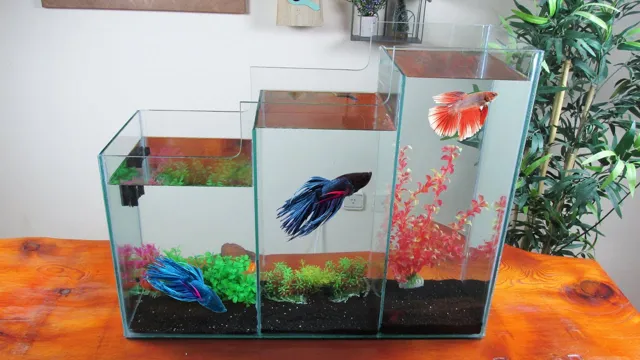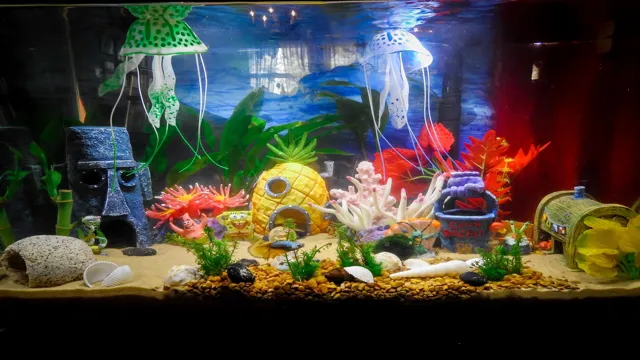Do you have a cloudy, milky mess in your aquarium? Don’t panic, this is a common issue that can be resolved with the right approach. In this comprehensive guide, we’ll walk you through everything you need to know about clearing up milky white aquarium water. First, let’s identify the root cause of this murky water.
It could be due to a number of factors, including overfeeding your fish, inadequate filtration, or an imbalance in the water’s chemistry. Once you’ve determined the cause, it’s time to take action and restore clarity to your tank. There are several steps you can take to clear up your aquarium water, such as performing partial water changes, improving filtration, and even adding specialized products to assist in removing impurities.
We’ll cover each method in detail, providing you with all the information you need to make the best decision for your aquarium. It’s important to note that clearing up milky aquarium water may take time and patience, and it’s crucial to avoid overreacting and making the situation worse. With a little bit of effort, you can restore your tank to its vibrant, healthy state.
In conclusion, having cloudy aquarium water can be frustrating, but it’s important to remain calm and take the necessary steps to resolve the issue. This comprehensive guide will help you navigate through the process, allowing you to enjoy a clear, beautiful aquarium for years to come.
Identify the Cause of the Cloudiness
If you’re dealing with milky white aquarium water, the first step in fixing the problem is to identify the cause. This cloudiness is often caused by excess debris or waste in the water, which can come from overfeeding your fish or inadequate filtration. Sometimes, it can also be caused by high levels of bacteria or algae growth.
To fix the issue, start by doing a thorough water change and vacuuming the substrate. This will remove any excess waste and debris from the tank. Then, take a look at your filtration system and make sure it’s adequate for the size of your tank and the number of fish you have.
Consider upgrading your filter or adding an additional one if necessary. If high levels of bacteria or algae are the problem, you can use a water clarifier or add some live plants to naturally filter the water. By taking these steps and addressing the root cause of the cloudiness, you can clear up your aquarium water and create a healthier environment for your fish.
Testing Water Parameters
When it comes to cloudy water in your aquarium, the first step is to identify the cause of the issue in order to fix it properly. Testing water parameters is crucial for determining the root of the problem. Check for excessive levels of ammonia, nitrites, and nitrates, as high levels can lead to cloudy water.
If these levels are within a reasonable range, it could be a bacterial bloom caused by too much organic waste in the tank. Regular water changes and proper filtration can help prevent this from occurring. Additionally, consider the type and amount of food being fed to the fish, as excess food can contribute to cloudy water.
Keeping a close eye on water parameters and addressing any imbalances will help keep your aquarium water clear and healthy for your fish.

Checking Filtration System
When it comes to maintaining a clean and clear pool, one of the most important aspects is the filtration system. If you notice cloudy water, the first step is to identify the cause. This can be due to a variety of factors, such as an overworked or undersized filter, poor water chemistry, or a lack of proper circulation.
One way to check if your filtration system is working is to inspect the filter and ensure it is clean and in good condition. If it appears dirty or damaged, it may need to be replaced or cleaned. Additionally, you can check the water flow and pressure gauge to ensure they are within the appropriate range.
By regularly checking and maintaining your filtration system, you can prevent cloudiness and ensure your pool remains clean and safe to swim in for all. Don’t forget that regular maintenance is key to keeping your pool in top shape!
Overfeeding or Overstocking
If your aquarium is cloudy, one of the causes could be overfeeding or overstocking. When you overfeed your fish, excess food will sink to the bottom and decay, leading to the growth of bacteria that cloud up the water. Overstocking, on the other hand, puts too much pressure on your filtration system, leading to poor water quality and cloudiness.
Both of these issues can be resolved with a few adjustments. First, it’s important to feed your fish in moderation, giving them only what they can eat in two to three minutes. It’s also advisable to stock your aquarium based on the size and filtration capacity of your tank, allowing about one inch of fish for every gallon of water.
By being mindful of your feeding and stocking habits, you’ll not only keep your aquarium clear but also ensure the health and well-being of your fish.
Perform a Water Change
If you’re dealing with murky water in your aquarium, never fear! There is one simple solution that can get your water looking crystal clear in no time: performing a water change. This is often the first step in treating any water quality issue in your aquarium. The process involves removing a portion of the water in the tank and replacing it with fresh, clean water. (See Also: How to Change Water pH in Aquarium: Quick Tips and Tricks)
This dilutes any harmful substances that may be causing your water to appear cloudy, as well as replenishes any essential minerals that may be in short supply. Ideally, you should perform a water change every one to two weeks, depending on the size of your tank and the number of fish you have in it. Not only will this help keep your water clear, but it will also keep your fish healthy and happy.
So go ahead and give your aquarium a good old-fashioned water change – your aquatic residents will thank you!
How Much Water to Change
Performing a water change in your fish tank is crucial for the health and well-being of your aquatic pets. But how much water should you change? It depends on the type of fish you have and the size of your tank. As a general rule of thumb, aim to change 10-15% of the tank’s water every week.
However, if you have a heavily stocked tank or larger fish, consider increasing the percentage to 25% or more. It’s also essential to make sure that the temperature and pH levels of the new water match those in the tank before adding it. By performing routine water changes and maintaining proper water conditions, your fish will thrive and live a long, happy life in their aquatic home.
Don’t forget to test your water regularly to ensure it’s within the optimal range for your fish to thrive.
Preparing Water for Change
Performing a water change is an essential aspect of maintaining a healthy aquatic environment. It involves removing a portion of the tank water and replacing it with fresh, clean water. The first step in performing a water change is to prepare the water.
This involves filling a clean bucket with tap water and adding a dechlorinator to remove any harmful chemicals. It is crucial to ensure that the water is at the correct temperature and pH level to avoid any shock to the fish. You can achieve this by testing the water with a reliable kit.
Once the water is prepared, you can start the process of siphoning out the old water from the tank. You can do this using a gravel vacuum, which removes debris from the bottom of the tank and carries it out with the water. Finally, you can add the fresh, clean water to the tank at the same temperature and pH level as the aquarium to avoid any stress on the fish.
Performing a water change is an easy and effective way to maintain a healthy and happy aquatic environment for your fish.
Performing the Water Change
Performing a water change is an essential aspect of maintaining an aquarium’s health. This process involves replacing a portion of the old water in the tank with fresh, clean water. The amount of water to be changed depends on the tank’s size and the number of fish living in it.
Typically, a 20% to 25% water change is recommended every two weeks. Before starting the water change process, make sure to turn off all electrical equipment, including filters, heaters, and lights. Next, use a siphon to drain the water from the tank into a container.
Avoid removing too much water at once to prevent stressing out the fish. Once the old water is out, gently pour in the new water, making sure that it matches the temperature and pH level of the tank water. Finally, turn on the equipment and let the tank settle for a while.
Performing a water change regularly ensures that the fish have a clean and healthy environment to live in, reducing the risk of diseases and other complications.
Add Water Clarifiers and/or Beneficial Bacteria
If you’re dealing with milky white aquarium water, there are a few things you can do to clear it up. One effective solution is to add water clarifiers. These products work by binding together the small particles that are causing the water to appear cloudy, making them easier for your aquarium filter to remove.
Another solution is to add beneficial bacteria to your aquarium. These microorganisms help break down organic matter in the water, which can also contribute to cloudiness. They can also help establish a healthy biological balance in your tank, which can prevent future water quality issues.
When choosing a water clarifier or beneficial bacteria product, be sure to follow the instructions carefully and dose your tank appropriately. It’s also a good idea to test your water regularly to make sure you’re maintaining good water quality. With some patience and care, you can clear up milky white aquarium water and create a healthy environment for your fish. (See Also: How to Change KH in Aquarium: A Step-by-Step Guide for Better Water Chemistry)
Types of Clarifiers and Bacteria
Adding water clarifiers and/or beneficial bacteria is a common practice used in pond maintenance. There are a few different types of clarifiers available, including chemical and biological, and they each function in different ways. Chemical clarifiers work by coagulating small particles, which can then be easily removed from the water.
Biological clarifiers, on the other hand, use beneficial bacteria to break down organic matter in the water, making it cleaner and clearer. These bacteria, which are naturally occurring in pond ecosystems, play a crucial role in maintaining water quality and keeping fish and other aquatic life healthy. By adding additional bacteria to a pond, you can help ensure that there are enough to keep the ecosystem in balance.
Water clarifiers and beneficial bacteria can be added as a routine part of maintenance, or used to address specific issues like cloudy or green water. When choosing a clarifier or bacteria product, it’s important to select one that’s appropriate for your pond size and needs. Additionally, be sure to follow all instructions carefully to avoid damaging your pond or harming its inhabitants.
Overall, adding water clarifiers and beneficial bacteria is an excellent way to promote a thriving pond ecosystem.
Effectiveness and Frequency of Use
When it comes to maintaining a clear and healthy pond, using water clarifiers and beneficial bacteria can be effective tools. Water clarifiers work by binding together small particles in the water, making them easier to filter out. Beneficial bacteria, on the other hand, help break down organic waste and excess nutrients in the water, reducing the chances of algae blooms and other issues.
However, it’s important to use these products regularly and in the correct amounts for them to be truly effective. Depending on the size of your pond, you may need to use them once a week or more. It’s also important to read the instructions carefully and follow them closely, as using too much of these products can actually do more harm than good.
By incorporating water clarifiers and beneficial bacteria into your pond maintenance routine, you can help keep your pond clean and healthy for years to come.
Maintain Proper Aquarium Care
Maintaining proper aquarium care is essential to keep your fish healthy and happy. One common problem that fish owners face is milky white aquarium water. This can be caused by a variety of factors, such as overfeeding, poor filtration, lack of water changes, or an excessive amount of organic waste.
To clear this cloudy water, the first step is to identify the root cause and address it accordingly. Be sure to test your water parameters regularly and adjust your filtration system as needed. Additionally, avoid overfeeding your fish and perform regular water changes to eliminate excess waste.
You can also use a water clarifier or aquarium salt to help clear up the water. Remember to stay consistent with your aquarium maintenance routine to keep your tank clean and healthy for your fish to thrive.
Regular Water Changes
Regular water changes are an essential aspect of maintaining proper aquarium care. Changing a portion of the water in your aquarium regularly is incredibly crucial for the well-being of its inhabitants, as it removes any excess waste and harmful particles that build up over time. It also helps maintain the water’s chemical balance, ensuring your fish and plants have the ideal environment to thrive in.
But how often should you change the water in your aquarium? Well, that depends on the size of your tank, the number of fish you have, and the aquarium’s filtration system. A general rule of thumb is to change 10-20% of the water every one or two weeks. Still, it’s best to monitor the aquarium conditions regularly to ensure you stay on top of any water quality issues that may arise.
Remember that water changes are a fundamental practice for any aquarium owner and are critical to providing the best care for your aquatic pets.
Proper Feeding and Stocking
Maintaining proper feeding and stocking is essential to keeping your aquarium healthy and thriving. It’s important to research the specific needs of your aquatic species and provide them with the right type and amount of food. Overfeeding can lead to excess waste and poor water quality, while underfeeding can result in malnutrition and stunted growth.
In addition to feeding, it’s crucial to appropriately stock your aquarium with compatible species and not overcrowd your tank. Overstocking can lead to aggressive behavior, stress, and disease among the inhabitants. Consider the adult size and behavior of each species before adding them to your aquarium and be mindful of the recommended stocking levels. (See Also: How to Attract Snails in Aquarium: Tips and Tricks for a Thriving Aquatic Environment)
With proper feeding and stocking practices, you can create a harmonious and happy aquatic habitat.
Cleaning and Maintaining Filtration System
Maintaining a clean and healthy aquarium is crucial for the well-being of your aquatic pets. One of the most important things to consider when it comes to aquarium care is the filtration system. A quality filtration system is essential for maintaining the cleanliness and purity of the aquarium water.
To keep your filtration system working properly, it’s important to perform regular maintenance. This includes cleaning the filter media and replacing it when necessary. Additionally, be sure to check the water flow rate and adjust it as needed.
Neglecting your filtration system can lead to a buildup of harmful toxins and bacteria in the tank, which can have devastating consequences for your aquatic pets. So, make sure to prioritize proper care and maintenance of your filtration system to keep your aquarium thriving.
Conclusion
Clearing milky white aquarium water is as much an art as it is a science. Simply changing the water and adding some chemicals may work for some tanks, but others require a more delicate balance of filtration, lighting, and proper nutrition. Just like an artist chooses the right brush and paint, an aquarist must carefully select the right tools and techniques to achieve a crystal-clear aquarium.
So, whether you’re a seasoned pro or a newcomer to the aquarium world, with some patience, perseverance, and a little creativity, you can transform even the cloudiest of waters into a breathtaking aquatic masterpiece.”
FAQs
What causes milky white water in aquariums?
Milky white water in aquariums can be caused by a bacterial bloom, overfeeding, an excess of nutrients, or a lack of water flow.
How can I prevent milky white water in my aquarium?
To prevent milky white water in your aquarium, ensure you are not overfeeding your fish, remove any excess food and debris from the aquarium, and perform regular water changes to remove excess nutrients.
Is milky white water harmful to fish and other aquatic species?
Milky white water can be harmful to fish and other aquatic species if left unaddressed for an extended period of time. Bacterial blooms can deplete oxygen levels in the water, which can be fatal to fish and other aquatic life.
How often should I perform water changes to keep my aquarium clear?
The frequency of water changes to keep an aquarium clear will depend on the size of the aquarium, the number and types of fish, and the filter system being used. In general, it is recommended to perform a 25-30% water change every 2-4 weeks.
Can adding plants to my aquarium help clear milky white water?
Adding live plants to your aquarium can help to improve water quality by absorbing excess nutrients and releasing oxygen. However, plants on their own may not be enough to completely clear milky white water.
What types of filters are best for keeping aquarium water clear?
The best types of filters for keeping aquarium water clear are those that are designed to remove particles and debris from the water, such as canister filters, power filters, and sponge filters.
Can UV sterilizers be used to clear milky white water?
Yes, UV sterilizers can be effective in clearing milky white water by killing off bacteria and other microorganisms. However, it is important to note that UV sterilizers should not be relied on as the sole method for maintaining water quality in an aquarium.







